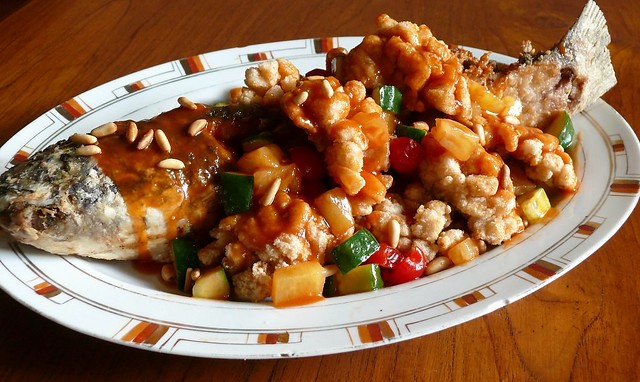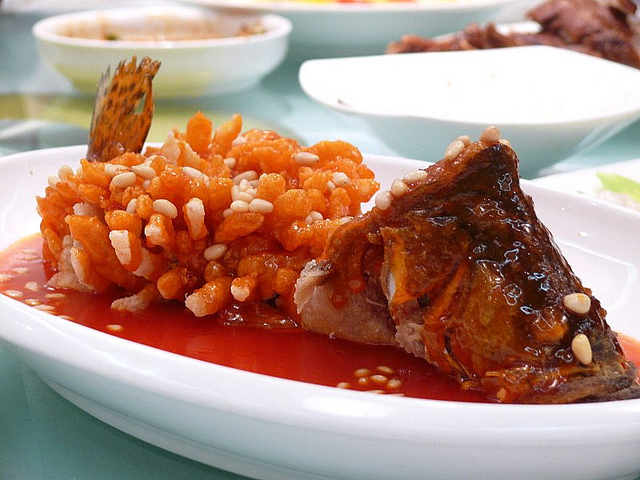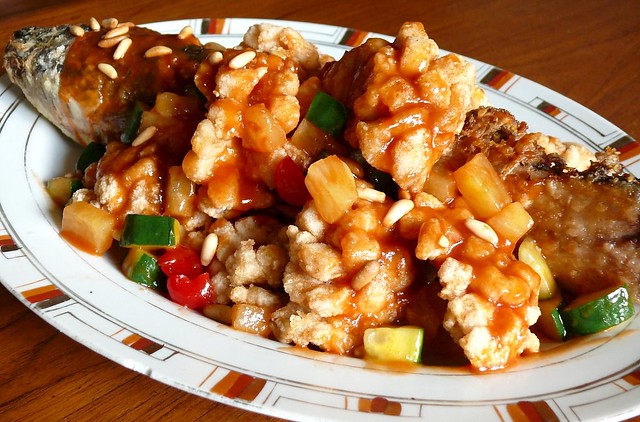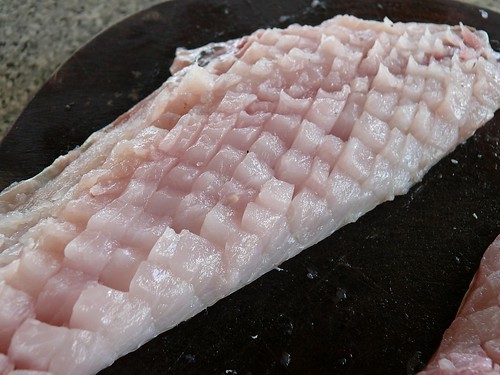One of the most typical Chinese dishes, especially in western countries, is sweet and sour pork (gu lao rou) which becomes sweet and sour fish when the pork is replaced with fish. Gourmets of Chinese food know that if the waitor recommends sweet and sour fish, especially fish slices and not whole fish, the fish is likely to be frozen or not fresh enough for steaming because for the Chinese, fresh fish is live fish. Smothered with sweet and sour sauce, frozen or fish that's not so fresh can be disguised because the taste is diverted to the sauce. If your hosts order steamed fish, you know that the fish is very fresh because only fresh fish can stand up to light steaming with minimal ingredients. That said, sweet and sour dishes are very popular, usually with kids and those with less discerning taste buds. I do enjoy sweet and sour fish once in a while because we eat steamed fish at least once a week and it gets boring.
Sweet & Sour Fish
1 whole fish, about 1 kg
salt & white pepper
1 egg white, lightly beaten
1 cup cornflour
oil for frying
The Sauce:
1 T white vinegar*
4 T tomato ketchup
3/4 cup diluted chicken stock
2 t sugar, or to taste
1/2 t salt
2 t Worchestershire sauce
2 t cornstarch
--mix above ingredients well and season to taste
1 cup of green peas or diced cucumber, pineapple, cherries, chilies etc for color
1 T toasted pinenuts
* if using canned pineapple, I substitute the water with the water from the can and decrease the sugar to 1 teaspoon.
1. Clean and scale the fish. Wipe dry with paper towels. Remove the fillets (keep the skin on) and feel for the bones with your hands and remove them. Season the fillets and fish skeleton lightly with salt and pepper and massage them with beaten egg white . Turn the fillets flesh-side up and cut diagonal lines 3/4 cm apart deep into the flesh and to the skin but don't cut through. Cut diagonal lines in the opposite direction to make a diamond pattern. Cut the fillets into 4 x 6 cm slices and thoroughly coat the flesh, opening it up and getting all the cut sides. Coat the fish's skeleton and head with cornflour.
2. Heat about 5 cups of oil for deep-frying. When oil begins to smoke, fry the fish's skeleton until golden and arrange on an oval plate. Now fry the fillets in 2 or 3 batches until crispy and golden. For prettier results, open up the flesh neatly so that they spread out. Arrange the fried fillet pieces around the skeleton.
3. Pour all the oil away and add the sauce ingredients and the veggies to the wok or frying pan. For a more classy looking dish, omit the veggies and use pinenuts to garnish. Cook over medium heat until thickened but not too thick. Add some water if it gets too thick. If you want a shiny sheen, add a tablespoon of the oil from frying the fish to the sauce and stir well. Season to taste if necessary. Pour the sauce over the fish and sprinkle pinenuts all over.
The fish I ate in Shanghai
This sweet and sour fish is based on a beautiful (in sight and taste) dish I ate in Shanghai last year. I couldn't get the flesh of the fish as elegantly opened like a coral or flower because I wasn't sure if the flesh'll fall apart if I cut it too finely. It was fun though to cook this dish. Put on an 'antique' ceramic plate from my mom, the fish looked restaurant-worthy. It was delicious too except that I was a little bit disappointed that the salt-water fish didn't have that special flavor found only in those fresh-water fishes of China. Again, in my opinion, sweet and sour fish is more about the fried flavor and the sauce. All-in, still, a delicious and showy dish that is good for festive occasions.
This sweet and sour fish is based on a beautiful (in sight and taste) dish I ate in Shanghai last year. I couldn't get the flesh of the fish as elegantly opened like a coral or flower because I wasn't sure if the flesh'll fall apart if I cut it too finely. It was fun though to cook this dish. Put on an 'antique' ceramic plate from my mom, the fish looked restaurant-worthy. It was delicious too except that I was a little bit disappointed that the salt-water fish didn't have that special flavor found only in those fresh-water fishes of China. Again, in my opinion, sweet and sour fish is more about the fried flavor and the sauce. All-in, still, a delicious and showy dish that is good for festive occasions.
Sweet & Sour Fish
1 whole fish, about 1 kg
salt & white pepper
1 egg white, lightly beaten
1 cup cornflour
oil for frying
The Sauce:
1 T white vinegar*
4 T tomato ketchup
3/4 cup diluted chicken stock
2 t sugar, or to taste
1/2 t salt
2 t Worchestershire sauce
2 t cornstarch
--mix above ingredients well and season to taste
1 cup of green peas or diced cucumber, pineapple, cherries, chilies etc for color
1 T toasted pinenuts
* if using canned pineapple, I substitute the water with the water from the can and decrease the sugar to 1 teaspoon.
1. Clean and scale the fish. Wipe dry with paper towels. Remove the fillets (keep the skin on) and feel for the bones with your hands and remove them. Season the fillets and fish skeleton lightly with salt and pepper and massage them with beaten egg white . Turn the fillets flesh-side up and cut diagonal lines 3/4 cm apart deep into the flesh and to the skin but don't cut through. Cut diagonal lines in the opposite direction to make a diamond pattern. Cut the fillets into 4 x 6 cm slices and thoroughly coat the flesh, opening it up and getting all the cut sides. Coat the fish's skeleton and head with cornflour.
2. Heat about 5 cups of oil for deep-frying. When oil begins to smoke, fry the fish's skeleton until golden and arrange on an oval plate. Now fry the fillets in 2 or 3 batches until crispy and golden. For prettier results, open up the flesh neatly so that they spread out. Arrange the fried fillet pieces around the skeleton.
3. Pour all the oil away and add the sauce ingredients and the veggies to the wok or frying pan. For a more classy looking dish, omit the veggies and use pinenuts to garnish. Cook over medium heat until thickened but not too thick. Add some water if it gets too thick. If you want a shiny sheen, add a tablespoon of the oil from frying the fish to the sauce and stir well. Season to taste if necessary. Pour the sauce over the fish and sprinkle pinenuts all over.





7 comments:
That looks awesome. Looks like something that came out of a top chinese restaurant. And probably taste way better.
my dad from shanghai taught my mum to cook this one, i think. in my memory sweet and sour fish used to be must-have in wedding ocassions and new year eve too.
That looks great. I think in China, they call it Sung Zi Yu - 松子鱼 (Pine Nut Fish).
I am speculating that some ancient Chinese chef must have came up with this dish when a pine nut dropped from the tree and hit him on his head.
I guess , if this is true, this only proves the point that we Chinese cares more about food than the Law of Universe!
2 words only: toasted pinenuts!!!!!
you could put them on .....
anything, yeah that's it, anything .....
and i would eat it.
i have read somewhere that they are becoming scarce (expensive) because in China where many of them come from the trees are being killed off or stunted by acid rain.
your fish looks awesome, big fan of this dish. seems that many Asian countries have a version.
i particularly like the way the cucumber and pineapple juices infuse into the sauce.
a local version here also incorporates thin slices of lemon grass and shredded sour green mango into the melange, and then they garnish it with not only nuts but deep-fried crispy shallot slivers.
i first started eating this as a child in the local NYC Chinese restaurant that my Dad took us to every Sunday. we always thought it was so extravagant.
shaz: tq:))) it did haha
jim:sweet n sour fish reminds me of new york n san francisco...
roger: u know what, i shd've checked my sh photo b4 i cooked the fish. i htink sung zi yu is so much classier:D
ah, u are as funny as greg! i like tt:)
lunchguy:pine nuts were dirt cheap when i first went to china but now they can be more expensive than in oz unless you know where to buy them.
wow, the thai version sounds crazily good. hey, you commented about duck fat and garlic. can you tell me what i can do with the bit of duck fat that i have, and garlic? am thinking boil the garlic until soft, toast or fry with the fat and use on baguette?? sounds good?
you could do that
or
cut the top off a few bulbs of garlic and use duck fat in the same way you would us olive oil when roasting the garlic. just put some on the cut top, wrap in foil and roast in a low oven until golden and soft.
slow is always better.
a pinch of salt will also help to encourage/enhance the garlic flavor if your diet allows for salt.
if you are a maniac like me, resreve/freeze the garlic husks until accumulated and throw theminto your next batch of chicken stock that would not have to be "bland", or stuff them into a chicken before roasting.
"layered" flavors and scents add a subtlty to your food that guests will enjoy, but not be able to put ther fingur on.
3 flavor boosting rules of thumb:
salt with garlic
thyme with onions
marjoram with mushrooms
juniper berries & rosemary with game
also, when combining meats on a plate remember this: if the animals get along in the barn yard, and have no problems living together, then they will also go well on the plate.
(now don't go and ask me why chicken and lobster are great together. ha ha ha)
Hi Terri,
I have the same 'antique' plate like yours too! 'inherited' from my late mom. I think they are from the early 60s era. Maybe bought from the same shop in KK.
Anna
Post a Comment